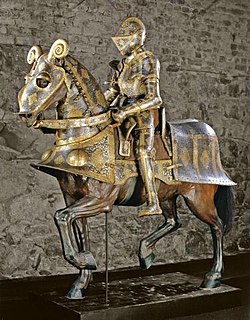
Mail or maille is a type of armour consisting of small metal rings linked together in a pattern to form a mesh. A coat of this armour is often referred to as a hauberk, and sometimes a byrnie.
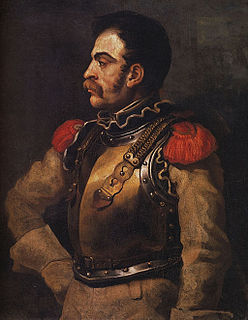
A cuirass is a piece of armor, formed of a single or multiple pieces of metal or other rigid material which covers the torso. The use of the term "cuirass" generally refers to both the chest plate and the back piece together. Whereas a chest plate only protects the front and a back plate only protects the back, a cuirass protects both the front and the back.

Cuirassiers were cavalry equipped with armour and firearms, first appearing in late 15th-century Europe. The first cuirassiers were produced as a result of armoured cavalry, such as the man-at-arms and demi-lancer, discarding their lances and adopting the use of pistols as their primary weapon. In the later 17th century, the cuirassier lost his limb armour and subsequently employed only the cuirass, and sometimes a helmet. By this time, the sword was the primary weapon of the cuirassier, pistols being relegated to a secondary function.

White armour, or alwyte armour, was a form of plate armour worn in the Late Middle Ages characterized by full-body steel plate without a surcoat. Around 1420 the surcoat, or "coat of arms" as it was known in England, began to disappear, in favour of uncovered plate. Areas not covered by plate were protected by mail sewn to the gambeson underneath.

A gorget, from the French gorge meaning throat, was a band of linen wrapped around a woman's neck and head in the medieval period or the lower part of a simple chaperon hood. The term later described a steel or leather collar to protect the throat, a set of pieces of plate armour,or a single piece of plate armour hanging from the neck and covering the throat and chest. Later, particularly from the 18th century, the gorget became primarily ornamental, serving as a symbolic accessory on military uniforms, a use which has survived in some armies.

A brigandine is a form of body armour from the Middle Ages. It is a garment, generally heavy cloth, canvas or leather, lined with small oblong steel plates riveted to the fabric.
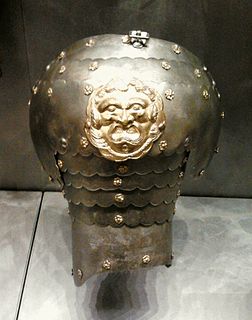
A pauldron is a component of plate armor, which evolved from spaulders in the 15th century. As with spaulders, pauldrons cover the shoulder area. Pauldrons tend to be larger than spaulders, covering the armpit, and sometimes parts of the back and chest. A pauldron typically consists of a single large dome-shaped piece to cover the shoulder with multiple lames attached to it to defend the arm and upper shoulder. On some suits of armour, especially those of Italian design, the pauldrons would usually be asymmetrical, with one pauldron covering less and sporting a cut-away to make room for a lance rest.
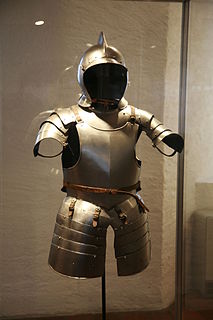
An Almain rivet is a type of flexible plate armour created in Germany in about 1500. It was designed to be manufactured easily whilst still affording considerable protection to the wearer. It consisted of a breastplate and backplate with laminated thigh-guards called tassets.
Almain rivets were generally of fairly low quality, but they were cheap: a royal proclamation issued by Henry VIII in 1542 designated them at 7s 6d, which equated to one sixth of the cost of a suit of demi-lance armor.
Almain rivets were frequently purchased en masse as munitions-grade armour to equip royal armies or personal retinues.

Aboriginal breastplates were a form of regalia used in pre-Federation Australia by white colonial authorities to recognise those they perceived to be local Aboriginal leaders. The breastplates were usually metallic crescent-shaped plaques worn around the neck by wearer.

The lobster-tailed pot helmet, also known as the zischägge, horseman's pot and harquebusier's pot, was a type of post-Renaissance combat helmet. It became popular in Europe, especially for cavalry and officers, from c. 1600; it was derived from an Ottoman Turkish helmet type. The helmet gradually fell out of use in most of Europe in the late 17th century; however, the Austrian heavy cavalry retained it for some campaigns as late as the 1780s.

A corslet is defined by the Oxford English Dictionary as "a piece of defensive armour covering the body." In ancient Egypt, Ramesses II is said to have worn a similar device in some battle(s). In Ancient Greek armies, the 'hoplite', or heavy infantryman, wore a bronze corslet or known as the thorax to protect his upper body. The corslet consisted of two plates connected on the sides via hinges and bronze pins. By the 16th century, the corslet, also spelled corselet, was popular as a light-half-armour for general military use, e.g., by town guards. It was made up of a gorget, breast covering, back and tassets, full arms and gauntlets.
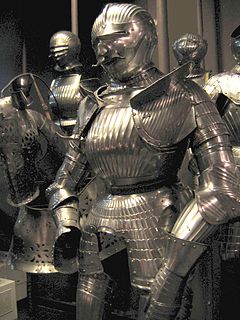
Maximilian armour is a modern term applied to the style of early 16th-century German plate armour associated with, and possibly first made for the Emperor Maximilian I. The armour is still white armour, made in plain steel, but it is decorated with many flutings that may also have played a role in deflecting the points and blades of assailants and increasing the structural strength of the plates. It is a transitional stage in the decoration of armour, after the plain steel surfaces of 15th-century armour and before the elaborate decoration and colouring with etching and other techniques of Renaissance armour. The armour is characterized by armets and close helmets with bellows visors; small fan-shaped narrow and parallel fluting—often covering most of the harness ; etching; work taken from woodcuts; sharply waisted cuirasses, and squared sabatons.
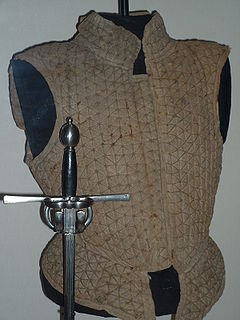
A jack of plate is a type of armour made up of small iron plates sewn between layers of felt and canvas. They were commonly referred to simply as a "jack". This type of armour was used by common Medieval European soldiers and the rebel peasants known as Jacquerie.

A coat of plates is a form of segmented torso armour consisting of overlapping metal plates riveted inside a cloth or leather garment. The coat of plates is considered part of the era of transitional armour and was normally worn as part of a full knightly harness. The coat saw its introduction in Europe among the warring elite in the 1180s or 1220s and was well established by the 1250s. It was in very common usage by the 1290s. By the 1350s it was universal among infantry militias as well. After about 1340, the plates covering the chest were combined to form an early breastplate, replacing the coat of plates. After 1370, the breastplate covered the entire torso. Different forms of the coat of plates, known as the brigandine and jack of plates, remained in use until the late 16th century.
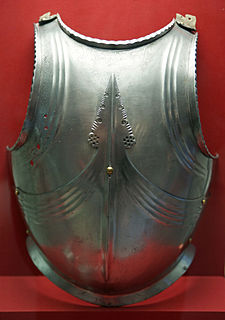
A plackart is a piece of medieval and Renaissance era armour, initially covering the lower half of the front torso. It was a plate reinforcement that composed the bottom part of the front of a medieval breastplate. They were predominantly worn in the 15th century. Sometimes they were worn with a metal finish, while the top part of the cuirass was covered in material, the difference in finish making a contrast.

Laminar armour is an armour made from horizontal overlapping rows or bands of solid armour plates, as opposed to lamellar armour, which is made from individual armor scales laced together to form a solid-looking strip of armor.
Prominent examples of such armour are lorica segmentata and certain versions of samurai armour.

Kusari gusoku (鎖具足) is the Japanese term for mail armour. Kusari is a type of armour used by the samurai class and their retainers in feudal Japan. When the word kusari is used in conjunction with an armoured item it usually means that the kusari makes up the majority of the armour defence.

